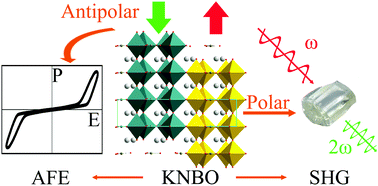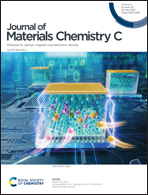Lead-free polar borate crystal K3Nb3B2O12: a novel antiferroelectric structure type†
Abstract
Antiferroelectric (AFE) materials have attracted tremendous attention and research interest as a family of important multifunctional electroactive materials, due to the special double polarization versus electric field (P–E) hysteresis loops. However, AFE compounds are quite rare and structure types of AFE materials are considerably scarce. It is tremendously difficult to find new AFE materials with a novel structure type. In this work, we discovered a new lead-free AFE crystal, K3Nb3B2O12 (KNBO), which is the first borate AFE material that provides a novel structure type for the AFE materials. Another extraordinary feature of KNBO crystal is that it crystallizes in the polar space group P21ma, exhibiting a moderate second harmonic generation response (0.24 × KH2PO4), which is unusual for AFE materials. Local dipole moment calculation was performed to analyse the structure–property relationships, which reveals that anti-polar and polar structures coexist in the KNBO crystal, moreover the anti-polar direction is perpendicular to the polar direction. This special structural characteristic leads to the coexistence of the AFE effect and SHG response. The discovery and characterization of the KNBO AFE crystal not only provide a new insight into the structure–property relationships of AFE materials, but also indicate a new way for searching and designing AFE functional materials.



 Please wait while we load your content...
Please wait while we load your content...